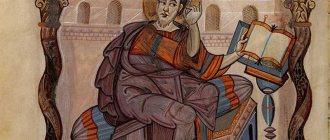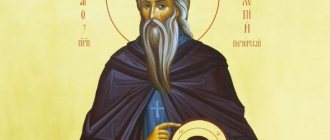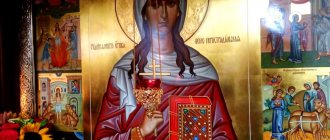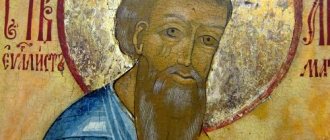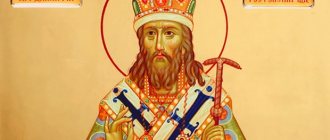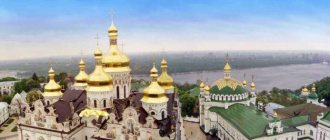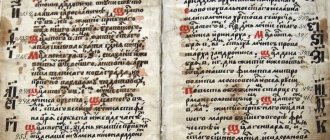Information about the early years and the beginning of service to God
The Monk Anthony is mentioned very sparingly in the chronicles, the priests say little about him, we learn the biography of the saint from the records of the Monk Theodosius and the Chronicle of Memorable Years. The monk quietly appeared on the banks of the Dnieper in times of passion and turbulent events, and also quietly left, forever leaving a mark in the Kyiv mountains.
Holy Venerable Anthony of Pechersk
It is known that young Antipas was born in 983 and lived in the city of Lyubech, in the Chernigov region. He left his father’s house very young and went to look for followers of Christ, ends up in Constantinople, and from there Antipas’ path lies to the holy Mount Athos. The Lord already saw in Antipas a sower of God’s word in Rus', thanks to his spiritual qualities:
- perseverance;
- strength of faith;
- intolerance towards paganism and perishable abominations.
In Rus' at the beginning of the second millennium there were still no Russian enlighteners, although churches and monasteries were growing. Metropolitan Michael brought with him the clergy, who had difficulty accepting the customs of the Slavs and suffered from such missionary work.
The Lord was looking for Cyril and Methodius' zeal for God, and his choice fell on young Antipas.
By the beginning of the second millennium, Athos was the center of Christianity; dozens of monasteries and individual churches grew on its hills and mountains. At the end of the 9th century, when the Islamic religion and Judaism rose, the Orthodoxy of Rus' and the Athos brotherhood became a single stronghold, the mediator between them was a weak man, exalted by God, Antipas from the Chernigov region.
More about the elders called Pechersky:
- Alypiy, icon painter of Pechersk
- Venerable Agapit of Pechersk
- Life of St. Theodosius of Pechersk
Anthony's caves in Chernigov
1069
Anthony escapes from the wrath of the Kyiv prince Izyaslav to the city of Chernigov
In 1069, Anthony hastily fled from the wrath of the Kyiv prince Izyaslav to the city of Chernigov. Izyaslav, the son of Yaroslav the wise, was influenced and changeable in his decisions. He believed the slander about Anthony's conspiracy with his enemies. At that time, the Yaroslavich brother-princes were at enmity in Rus'. The stumbling block was the redistribution of land plots.
In Chernigov, Anthony received the support of Prince Svyatoslav, but the monk sought peace. He dug a cave on the Boldin Mountains and secluded himself in it. Soon, as had already happened more than once, monks began to settle near his monastery.
To this day, the Trinity Monastery stands on this site. Under the ground there is a cave Christian monastery with many tunnels.
Anthony’s choice of the Boldin Mountains is interesting. The place is mystical and ambiguous. It was there that in pre-Christian times there stood an ancient pagan sanctuary with idols and a temple of the god Perun. There they performed rituals and made sacrifices to the pagan gods.
Anthony's caves grew into a large four-tiered monastery complex.
There is a legend about the figure of a monk who appears in the ghostly fog in the corridors of the tunnel.
Cell of the Trinity Monastery. On the site of this monastery there was once a cave named Anthony
Monk of Athos
On the holy Mount Athos, Antipas takes monastic vows with the name Anthony, so he was named in honor of Anthony the Great, on whose labors the young monk grew up. Saint Anthony the Great, who lived in the 3rd and 4th centuries, was the founder of hermit life; he is called the father of monasticism.
The traditions founded by the Great Hermit were subsequently brought to Kievan Rus by the father of Russian monasticism, Saint Anthony of Pechersk. The name Anthony translates as acquisition. Both Anthonys became a real acquisition for the Creator, through them the Creator acquired thousands of thousands of faithful followers.
What is the secret of Anthony the Great, who carried away monks from all countries and continents? His harsh way of life, refusal of all the benefits of a normal person, incessant fasting and prayer should have scared people away, but seeing the achievements of the saint, the victory over human weaknesses and the achievement of fortitude, the number of followers is constantly growing.
Cave of St. Anthony of Pechersk in the Athos Monastery
Anthony of Pechersk brings to Russian monasteries the testament of the great patron, which states that only through observing oneself in severity and abstinence can true joy be realized.
The Great Church of the Kiev Pechersk Lavra is the brainchild of Holy Father Anthony
The magical ringing of the golden bells of the Kiev Pechersk Lavra fills human souls with light and grace, attracting tourists and Orthodox pilgrims.
The Lavra, the founder of which was St. Anthony, is a unique structure of its kind. This is the largest complex of temples and monasteries. It includes:
- Assumption Cathedral;
- Church of the Nativity of the Blessed Virgin Mary;
- Temple of the Icon of the Mother of God “Joy of All Who Sorrow”;
- Church of All Saints, Church of the Exaltation of the Cross;
- Warm church in honor of the Venerable Fathers of Pechersk;
- Temple "Life-Giving Spring", erected in honor of the icon of the Mother of God;
- Refectory Church;
- Near and far caves.
The Lavra is divided into Upper and Lower. Upper-ground historical and cultural complex. Nizhnyaya - active monastery and Anthony's caves.
Return to Rus'
Having learned the depth of the life of monks, Anthony of Pechersk returns to Russian possessions, visits monasteries, monastic settlements and churches, and comes to the conclusion that nowhere in Rus' there is real monasticism, worldly troubles and earthly concerns are placed above the worship of God.
The death of Prince Vladimir the Great at the beginning of the 11th century causes new upheavals among believers. There is a struggle for the throne and a return to paganism. Saint Anthony again leaves Rus' and goes to Mount Athos for new instructions on how to establish a center of monasticism on the banks of the Dnieper.
Interesting! Upon his second return, having a clear plan for further service, the venerable envoy of Athos awaits the guidance of God himself, and at this time the Athos brethren earnestly pray for him.
The path to monasticism of St. Anthony of Pechersk
The icon depicts St. Anthony of Pechersk.
Anthony of Pechersk is a monk, hermit, ascetic and holy father. He is considered the founder of monasticism in the Russian Orthodox Church. The saint is also famous for being the founder of the Kiev-Pechersk Lavra.
He was born in 983 in Lyubech, located on the banks of the Dnieper. At birth he was given the name Antipas.
There is practically no information about the childhood and youth of Saint Anthony. What is known is that from an early age he truly believed in God. The pilgrim's path led him to Palestine, the place of the earthly ministry of Jesus Christ.
On the Greek peninsula of Athos, in the Esphigmen monastery, he took monastic vows and was named Anthony. For several years he served God in a secluded cave in the monastery.
Athos monastery Esphigmen. In it, Anthony was tonsured a monk
The first steps of monasticism in Rus'
By the will of God, St. This time Anthony of Kiev-Pechersk does not travel through the Russian lands, but settles in a prayer cave, which, before his return, was dug by Presbyter Hilarion, the future first Russian metropolitan, for solitude and prayer.
In fasting, with tears of repentance, the holy hermit equips the cave, expanding it.
The life of the saint, spent in this cave, consisted of prayerful activity; he became the Lord's ray illuminating the path to Russian Orthodoxy.
Amazing events are developing with rapid speed; soon, around the secluded cave in which the holy monk was practically motionless in prayer, caves of his disciples appeared, who come to the Monk Anthony of Pechersk for instructions and blessings.
Icon of St. Anthony of Pechersk
The blessings and instructions of the monk are subject to the strict rules of monastic life in solitude. Father Anthony arranges the life of the Nearby, in the future Anthony, monastery under the leadership of Abbot Theodosius, who has the gift of humility and meekness, and in 1057 he himself goes to the mountains, digging a new place of residence there, where the Theodosius Monastery was subsequently founded.
The monks find the mentor’s place of residence and begin to dig caves nearby. A new underground monastery is founded, then Anthony of Pechersk prays before the Lord and decides to build above-ground churches, the place for which was donated by the Kiev prince Izyaslav.
The fame of the amazing monk spread throughout the area, and people from peasants to boyars flocked to the saint’s cave. The Athonite prayer book had the gift:
- clairvoyance;
- healing;
- prophecies;
- mentoring;
- deep faith.
Fans of paganism twice organized pogroms in the caves, trying to expel the monks from there, but they returned again in meekness and humility. The first disciples, and later comrades-in-arms, were the Venerables Theodosius and Nikon, and the princes Izyaslav and Svyatoslav provided great support to the monastic movement.
Hermits such as Saint Isaac and others appeared in the Kyiv caves. Prince Izyaslav blesses the construction of the monastery in honor of Dmitry of Thessaloniki, and the Monk Varlaam is appointed its abbot. People went to the monastery with petitions and help, supporting financially the monks who lived in the caves. The Kiev-Pechersk brotherhood was in tears, prayers and vigil, asking God for the people living among the demonic evil spirits.
People went to caves for the power of faith, the ability to fast and abstain, repenting of sins and learning to pray. Without silver and gold, new souls who acquired enlightenment were acquired for the Almighty God.
Important! Through a poor old man who lived in a cave near Kyiv, God's light came to Kievan Rus. The blessed source of light attracted people in need.
Anthony's return to Rus' from the holy Mount Athos and the founding of Russian monasticism
Having received the knowledge and blessing of the abbot of the monastery, the ascetic returned to Russian soil. The Monk Anthony came to Kyiv, walked around the entire city, looked at the life and way of life of the monasteries. However, he did not want to serve in any of them.
The monk sought solitude, away from the bustle of the world, with the goal of devoting himself to God.
Monk Anthony voluntarily retired to cave cells on Berestovaya Mountain and began to lead the holy life of a hermit.
Reclusion is a kind of lifetime burial, because a person renounces all earthly goods.
A ledge in the wall served as his bed. Candle and icon furnishings of a monastic cell. Cold, dark, lonely. Anthony ate dry bread and water and slept on the bare ground. Such was the severe asceticism in which his spirit was strengthened.
Hermitage is considered the highest feat of serving the Lord. There are things in our world that only monks are destined to understand.
People learned about Anthony and reached out to him for his blessing. This is how the first followers appeared - Nikon and Theodosius, who wished to live next to him and learn monastic traditions. Theodosius of Pechersk came to Anthony at the age of 23, became a monk, and subsequently became a key figure in the history of the Russian Orthodox Church.
Kievan Rus of that time was distinguished by the weakness of faith and the immaturity of Christian thought. Greeks served as priests in the Russian Church; there were not enough theological books and knowledge.
Anthony passed on to his disciples the universal experience of Orthodoxy acquired on the holy mountain.
There were more and more people who wanted to renounce the world and devote themselves to God.
The monks dug a spacious cave, built a church and cells in it, where they served in severe asceticism.
Anthony, however, sought solitude. He appointed Blessed Varlaam as abbot over the brotherhood, and went into complete seclusion in a new cave. However, hermit monks again settled next to Anthony, eager to follow him and carry out the monastic feat.
With the arrival of new followers, the caves expanded. Thus, the Near and Far caves of the Lavra appeared.
Nearby caves contain underground temples:
- Introduction of the Blessed Virgin Mary;
- Venerable Anthony of Pechersk;
- Venerable Varlaam, abbot of Pechersk.
The Far Caves include the following temples:
- Nativity of Christ.
- Annunciation of the Blessed Virgin Mary.
- Venerable Theodosius, abbot of Pechersk.
| Nearby caves | 400 meters total length | the relics of 73 canonized saints rest |
| Far Caves | 300 meters. total length | the relics of 49 canonized saints rest |
Corridor of the Far Caves of the Kiev Pechersk Lavra.
Anthony of Pechersk became a recluse in them. Since ancient times, pilgrims have been visiting the Pechersk Caves. The galleries, open to the public, are a 12th-century monastic cemetery.
Foundation of the Kiev-Pechersk Monastery
The number of monks in the caves exceeded one hundred people; a palisade was erected around the newly built above-ground church and cells, which protected the Kiev Pechersk Lavra from the world. Strict rules applied in the newly created monastery:
- all monks must work unceasingly;
- there is no personal property in the monastery, everything is shared;
- daily morning and evening prayers;
- The abbot listens to all thoughts and prays for salvation.
These rules applied to everyone, from the abbot to the monk; those who were able to do so were assigned to chop wood, carry water, and work in the bakery.
History of the main cathedral of the monastery
Saints Theodosius and Anthony were in the same cave, when during prayer the Most Holy Theotokos appeared to them and spiritually transported the saints to the Blachernae Church of Constantinople, revealing to Saint Anthony the time of his death and promising not to leave the Pechersk monastery.
Icon of Saints Anthony and Theodosius of Pechersk
Soon craftsmen from Greece appeared at the doors of the monastery with gold, relics of saints and a bright image of the Mother of God; they said that the Mother of God ordered them to go to Rus' and build a church there for Her.
When choosing the location of the future shrine, Father Anthony decided to ask God where He would like to see the new temple. Like the prophet Elijah, the monk asked the Creator to indicate the construction site so that in the morning the very site of the future church would be dry, and let dew fall around it. The Lord gave an answer at the request of the monks. On the second day, they changed the conditions so that everything would turn out the other way around, and again God confirmed His decision, sending dew to the holy site, and the earth around was dry.
It was the third day, Saint Anthony took the golden belt and measured the perimeter of the future temple, after which all the vegetation on the site was burned out by fire. Thus the foundation of the Assumption Cathedral was laid.
ANTHONY
Several are known. types of image A.: individual, together with prp. Theodosius (as the organizers of the Kiev-Pechersk monastery), among the selected saints, on the icons of the Council of the Kiev-Pechersk Saints. From the Kiev-Pechersk Patericon it is known that already in the 12th century. there were icons of A. and others. Theodosius of the Kiev-Pechersk, who are the abbot of the monastery, St. Nikon showed it to those who came. The oldest image of A., standing before the Mother of God, was preserved on the Pechersk (Svensk) icon of the Mother of God, c. 1288? (Tretyakov Gallery): the saint is presented on the right, in a monastic robe with gold clasps, armbands, a lectern, a pointed schematic doll with crosses, his left hand in prayer, in his right there is an unfolded scroll with the text: “I pray that you hold on to God […] abstinence and not be lazy and […] but about this G[…]d helper,” on the left - St. Feodosius. This iconography became widespread in the 16th century. (for example, an icon of the 16th century (GMMK); an icon of the mid-17th century of northern letters (GTG); the centerpiece of the prophetic row of the iconostasis of the Assumption Cathedral in Tula, the 18th century; an icon of the 18th century (CMiAR)). A separate version of this iconography is represented by the icon of Ser. XIX century (CMiAR), on which the hands of the Mother of God are placed on the shoulders of A. and Theodosius. The latter most likely goes back to Ukrainian. 17th century engraving The oldest known example is in the Kiev edition of Akathists (1693). There are known examples of a complicated composition with frontal figures of Metropolitans Peter (to the left of A.) and Alexy (to the right of St. Theodosius), for example. in handwritten musical notes Irmologiya 1651 (NTs(L) Q. 339. L. 173 vol.; master Ioann Stefanovich) and 1691 (BAN. Collection of E. Kaluzhnyatsky 15. L. 212 vol.; master Konstantin Belinsky) .
St. Anthony Pechersky. Engraving. Kiev-Pechersk Patericon. K., 1661 Ave. Anthony Pechersky. Engraving. Kiev-Pechersk Patericon. K., 1661
During the restoration of the Assumption Cathedral in 1470, Vel. Kyiv prince Simeon Olelkovich decorated the outside of the temple with a slate carved triptych with life-size images of A. and St. Theodosius on the sides of the Virgin Mary (in the “Unbreakable Wall” type); later the triptych was inserted into the wall of the Lavra bell tower. According to the description of 1655, the archdeacon. Paul of Aleppo, in the local row of the iconostasis c. The Dormition of the Mother of God was an icon of the Venerables A. and Theodosius (known from its reproduction in a copper-cast model of the iconostasis, made by the permission of Nikon, Patriarch of Moscow and All Rus', for the installation of the iconostasis in the New Jerusalem Monastery (Petrov. Issue 3. p. 32)). Probably its copy is the icon of Saints A. and Theodosius of the Kiev-Pechersk (16th century? under the entry) of the Kiev letters (Petrov. Issue 2. p. 20), where the saints are depicted full-length, frontally, in schematic vestments, dolls, A. blesses with two fingers, a scroll in his left hand. A. together with St. Theodosius included in the composition of the lengthy venerable Deesis, written in the middle - 3rd quarter. XVI century (in the abbess of St. Cornelius) on the altar barrier of the chapel in the name of Anthony and Theodosius of the Pechersk cave church of the Dormition of the Most Holy. Our Lady of the Pskov-Pechersk Monastery (frescoes were unveiled in 1970). According to the inventory of 1585-1587, the Pskov-Pechersk Monastery was exceptionally rich in icons depicting A.; in the local row of the Assumption Cathedral there were separate icons of A. and St. Feodosia, invested in 1583-1584. among others, the Pskov landowner Pelageya Pushkina, and a common icon of these saints “on gold”; in c. The 40 Martyrs of Sebaste, their images were part of the 13-figure Deesis, and were also placed on the common local icon.
On the bells of the Kiev Pechersk Lavra, 1719-1720, in Ukrainian. icon of the beginning XIX century (NKPikz), on Rostov enamel icons, ser. XIX century and 2nd floor. XIX century (CMiAR) the monks are presented in prayer before the Mother of God and the Child, below, in the center, the Assumption Cathedral is depicted. The monks are also depicted standing before the venerated icons of the Mother of God: the Dormition of the Virgin Mary - on the icon. XVIII century (Petrov. Issue 3. P. 46. Fig. 24), on wooden pilgrim carved icons of the 19th century. (CMiAR); Czestochowa - on the icon of the beginning. XVIII century (CMiAR); Hodegetria - on a cast folding (Vygov casting) finish. XVIII - beginning XIX century (CMiAR).
The image of A. in the row of selected saints is placed in stamps on the margins of sewn shrouds, 2nd half. XV century: with the image of the Mother of God “The Burning Bush” from the Kirillov Belozersky Monastery (Russian Museum); “Assumption of the Virgin Mary” from the Vladimir Knyaginin Monastery (Tretyakov Gallery); “Appearance of the Mother of God St. Sergius of Radonezh" Moscow work (GMMK) - everywhere up to the waist, with his head uncovered, with a scroll in his hand; on the back of the double-sided embroidered shroud “Sophia the Wisdom of God - St. Nicholas the Wonderworker, Great Martyr. Nikita, Saints Anthony and Theodosius of Pechersk", 2nd half. XVI century, originating from c. Vmch. Nikita in Novgorod, where there was a chapel in the name of A. (Russian Museum), - frontal, full-length, in a doll. A. is also presented on the back of the Novgorod tablet “The Crucifixion of Christ - sschmch. Antipas, bishop Pergamon, Saints Anthony and Theodosius of Kiev-Pechersk", 2nd half. XV century (GTG); on the Pskov marching iconostasis, 3rd quarter. XVI century (TCG), - in the bottom row, among the reverends; in Ukrainian Icon “Guardian Angel with Saints Anthony and Theodosius of Pechersk”, 1st half. XIX century (NKPikz); in the stamp on the etching “View of the Esphigmen monastery on Mount Athos”, 1847 (State Literary Museum. Moscow), etc.
One-of-a-kind images of A. include the sewn cover of the beginning. XVI century (GRM), made for the Kiev-Pechersk monastery and invested in 1586 into the Kirill Belozersky monastery by the Moscow clerk Lev Voksharin: the doll is made of light silk, the monk blesses with two fingers and holds in his left hand an unrolled scroll with text similar to the inscription on the Pechersk icon. The image of the monk is on the 1st floor icon. XVI century (GTG) - waist-deep; on the icon of the beginning XX century (GE), made by M.I. Dikarev, - against the backdrop of a landscape with the Assumption Cathedral and the bell tower, full-length, with an unfolded scroll in his hand; placed in the menain cycles for May, for example, on the Vologda icon of the con. XVI century (VGIAHMZ) from c. in the name of St. Demetrius of Prilutsky, on the Rostov enamel icon. XVIII century (GMIR).
In the composition “Tree of the Kiev-Pechersk Saints”: on the icon of the 60s. XVII century (UIHM); on the wing of the panagia archim. Joseph (Trizna) 1655 by the Kyiv silversmith and engraver Theodore (Russian Russian Museum); on the frame of the Gospel of 1701 (NKPikz) - A. and so on. Theodosius is represented as planting a tree.
In the depiction of the Cathedral of the Kiev-Pechersk Saints (known in an engraving from the 1st half of the 18th century), A. is presented, as a rule, in the center, in front of a group of saints resting in the Near (Antony) caves: icon of the 1st half. XIX century from the workshop of the Kiev Pechersk Lavra? (CMiAR) - with an unfolded scroll in the right hand and a rosary in the left; colored lithograph of 1883 from the workshop of A. Abramov (Russian Russian Museum).
Sofia icon painting original, 2nd quarter. XVII century prescribes to depict A. “in the schema, near the head of the kudertsi small, gray, brad of John the Theologian, duckweed sankir with whitewash” (RNB. Sof. No. 1523. L. 151, May 7); in a later original, 30s. XIX century, his death is mentioned: “His priests, and deacons, and princes, and people, old and Russian, are buried in every likeness” (IRLI. Peretz. No. 524. L. 183 vol., July 10), variant inscriptions are indicated on the scrolls: “Behold, he went away in flight and ended up in the desert. Lord, establish me in this place, may there be on it the blessing of the Holy Mountains and my abbot, who tonsured me into the monastic rank" (L. 155 vol., May 6), "Whoever loves God will live the angelic life, vigilating, fasting, singing and praying always, thinking good for every man” (L. 233 vol.).
In the Radzivilov Chronicle (BAN. 34.5.30, end of the 15th century), under 1051, the “Tale of the Founding of the Pechersk Monastery” is placed, where 5 miniatures depict A. in a monastic robe, with his head uncovered, in the subjects: the tonsure of a saint on Athos and his return to Kyiv (L. 90 vol.); construction of A. cell on the banks of the Dnieper in a cave where St. Hilarion, Metropolitan Kiev, and the works of the monk (L. 91 - above); led book Kiev Izyaslav Yaroslavich asks the saint for blessings and prayers (L. 91 - below); A. supplies St. Varlaam as abbot of the Pechersk monastery and goes into the cave (91 vol.); St. Varlaam, abbot. Kiev-Pechersk, and the brethren ask A. for a blessing to expand the monastery, and one of the monks comes to the leader. book Izyaslav Yaroslavich for confirmation of the right to new lands (L. 92). Some of the scenes are reproduced in editions of the Kiev-Pechersk Patericon, for example, 1661 (with engravings by master Elijah), 1702 (engraver L. Tarasevich), where there are images of Simon the Varangian bringing a belt and crown to the monks A. and Theodosius, the Dormition of A., as well as scenes from the “Narration of the Creation of the Great Pechersk Church”: the appearance of the Virgin Mary, A., etc. Theodosius "mulars" in Blachernae, the arrival of architects with the icon of the Dormition of the Virgin Mary to A., etc. Feodosia to Kyiv, the miracle of indicating the site of the founding of the church with a pillar of fire, dew, the appearance of the Lord A.
In the publications of the Kiev-Pechersk printing house (since 1616), according to A. A. Guseva, the images of A. and Theodosius of the Pechersk were a kind of “publishing mark” (Guseva. P. 426), their images have great variability and are part of complex theological and allegorical compositions. Reverends A. and Theodosius are depicted on the sides of the Assumption Church, next to the entrances to the Near and Far Caves (Agapit, deacon of Glavizny. K., 1628). A. is represented in the composition “Tree of the Kiev-Pechersk Saints” on the frontispieces of the engraver Elijah for the Kiev-Pechersk Patericon (K., 1661) and “Akathists” (K., 1663), where A. and St. are depicted. Theodosius, “planting the tree,” - Assumption Cathedral. In a number of engravings, the saints are presented on the sides of the Mother of God or Her icons: “Pechersk (Svensk) icon of the Mother of God with 2 angels behind the throne” (Akathists. K., 1636); screensaver “Icon of the Mother of God “The Sign”, with the upcoming Saints Anthony and Theodosius” (Colored Triodion. Lvov, 1642) - A. without a doll; “Reverends Anthony and Theodosius in prayer before the icon of the Mother of God Hodegetria,” engraving by Dionysius Senkevich (Oktoich. Chernigov, 1682); “The Icon of the Dormition of the Mother of God with the Present Saints Anthony and Theodosius and Soaring Angels” (Conversations on the 14 Epistles of the Apostle Paul and St. John Chrysostom. K., 1623); headband “The Mother of God and Child, with half-length images on the sides of the Venerables Anthony and Theodosius” by master Elijah (Paterik, or Otechnik, Pechersky. K., 1661). There are also individual images of the saint: in the Festive Menea (K., 1619) - full-length, with an unrolled scroll in both hands; in “Trumpets of Preaching Words” by Lazar (Baranovich), Archbishop. Chernigovsky (K., 1674); in Akathists (K., 1693) - with selected saints in the fields. The image of A. with the marks of the life of the master Elijah is available in the ed. Kiev-Pechersk Patericon of 1661. The Dormition of the Saint is placed on the headpiece of the “Common Menaion with the Holiday” (K., 1680).
Allegorical compositions with the image of A. are known: an engraving from the book of Innocent (Gisel) “Peace with God for Man” (K., 1669), dedicated to Tsar Alexei Mikhailovich - A. and others. Theodosius in the form of six-winged seraphim; engraving from the “Common Menaion with the Holiday” (K., 1680), dedicated to Tsar Feodor Alekseevich - A. with a cross in his right hand and a crown in his left hand; engraving of the capture of Azov (see Azov Icon of the Mother of God) by L. Tarasevich (Paterik, or Fatherland, Pechersky. K., 1702) - full-length, with his head uncovered; engraving “The Crown of the Most Holy Theotokos” by master Elijah (Paterik, or Fatherland, Pechersky, 1661) - A. is represented from the waist up, “like the sun shining,” St. Theodosius “like the moon”, the monks of Kiev-Pechersk in the form of stars around the Virgin and Child.
Lit.: Rovinsky. folk pictures. T. 3-5; Petrov N.I. Album of sights of the Church and Archaeological Museum at the KDA. K., 1913. Issue. 2. P. 20, No. 4465. P. 29-33; Vol. 3. P. 46. Fig. 24; Antonova, Mneva. Catalog. T. 1. pp. 143-144. No. 92; T. 2. P. 35-36, 65, 492. No. 380, 416, 1028; Mayasova N. A. Old Russian sewing. M., 1971. S. 13-15; Ukrainian books of the Cyrillic press of the 16th-18th centuries: Catalog of publications stored in the OR GBL. M., 1976-1990. Vol. 1-2; Guseva A. A. Old printed book // 1000th anniversary of Russian artistic culture: Catalog. M., 1988. P. 426; Malkov Yu. G. Artistic monuments of the Pskov-Pechersky Monastery // Ancient Pskov: History, art, archeology. M., 1988. S. 200-203, 211; Forty forty. T. 1. P. 212; Markelov. Saints of Ancient Rus'. T. 2. P. 55-56; Catalog of the State Tretyakov Gallery. T. 1. pp. 70-71. Cat. 16; Russian monasteries: Art and traditions / State Russian Museum. B. m., 1997. P. 110.
I. B. Chernomaz
Life of Anthony of Pechersk
Venerable Anthony of Pechersk
You can find out details about the life of Anthony of Pechersk from his biography, which has survived to this day.
Lives of saints are literary works that present historical events and biographical facts from the lives of saints canonized by the Orthodox Church. Lives are the oldest literary genre.
The life of Saint Anthony is described by Saint Athanasius the Great. “The Life of Anthony of Pechersk” tells about the place and time of his birth, contains a description of pilgrimage, adoption of monasticism, talks about his labors and severe asceticism.
The Life says that the saint healed the sick with prayer and decoctions.
According to his biography, Anthony had the gift of working miracles, the gift of power over demons and natural forces.
He also had the gift of clairvoyance and a colossal gift of persuasion with words.
Therefore, he always had many followers. As soon as they listened to the monk, people of great wealth, of any age, military and civilian, relieved themselves of worldly burdens and became monks.
The monk spent almost his entire life underground in severe asceticism, wrote a lot, and addressed the monks with instructions and rules.
According to legend, the Most Holy Theotokos appeared to Saint Anthony and informed him of his imminent death. The reverend father prayed to the Mother of God that his relics would never be found by people, since he lived as a hermit.
The Monk Anthony, feeling that he would soon die, said goodbye to the monks and gave them instructions. The Holy Father went down into an underground tunnel and forbade the monks to follow him.
In a cave, five meters deep underground, he dug a grave for himself in advance. Anthony descended into the cave in front of the monks. Suddenly the ground collapsed behind him. The students repeatedly tried to find his remains. But the elements stood in their way, either fire burst out of the bowels of the earth, or a stream of water fell on them. To this day, the relics of Anthony of Pechersk have not been found.
In the place where the earth collapsed, there is an icon of Anthony of Pechersk. They pray to him for humility, for deliverance from passions, bad thoughts and for improved health.
The feat of a monk. Venerable Anthony of Pechersk
By leaving a comment, you accept the user agreement
